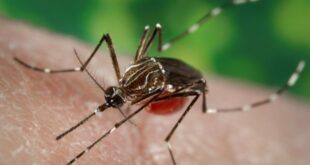A warm water mass that started heating up in May has been pushed towards the coast by Pacific winds.

A warm water mass heating up Pacific waters for months has arrived in B.C. — raising alarms about what impact those temperatures could have on marine life native to the coast.
The Pacific marine heat wave started forming about 1,600 kilometres off the coast in May, but in recent weeks has migrated west toward B.C. and Oregon. The warm water mass, about four million square kilometres in size, was predicted to wash up on B.C. shores by mid-August.
Over recent weeks, surface temperatures in the warm water mass have clocked in at up to five degrees higher than usual, prompting the U.S. National Oceanic and Atmospheric Administration to classify the heat wave as “extreme,” the highest level of classification.
Marine heat waves can cause extreme weather, fuel rising sea levels, and contribute to faster-melting ice caps — all while threatening marine life.
Here’s what you need to know about the one that has reached B.C. waters.
How do marine heat waves form?
Marine heat waves are a common occurrence in the Pacific — but climate change is increasing their frequency and severity.
Pacific marine heat waves generally begin when summer temperatures spike and high Pacific winds slow, quickly heating up the surface temperature of the water.
The top layer of the ocean, which normally mixes easily with the cooler water underneath, becomes thinner, and in turn, is heated up more easily by the sun — and with those conditions, a marine heat wave is born.

The marine heat wave currently being documented in the Pacific isn’t the only one scientists are watching.
Warm water masses have also been observed in the Gulf of Mexico, the Caribbean Sea, and the North Atlantic. Earlier this summer, the water temperature off the coast of Florida reached 37 C — hitting hot-tub levels of heat.
Researchers are also concerned about the sudden warm-up because oceans are crucial for the planet’s ability to absorb and store heat.
Studies have estimated oceans have absorbed around 90 per cent of the excess energy and heat stored in the planet’s climate system from greenhouse gas emissions over the last 50 years.
What is the impact on marine life?
While warm waters may be welcomed by swimmers, they can prove dangerous for coastal ecosystems and the sea life accustomed to cooler temperatures.
Martin Haulena, head veterinarian with the Vancouver Aquarium, said the impact of the marine heat wave will be felt across the ecosystem — from kelp to shellfish, seabirds, and the larger marine mammals that populate B.C. waters.
“Warmer water tends to have a lot less oxygen in it than cold water. So your basic productivity is decreased, and that means a lot of the primary food substances for a lot of the animals that marine mammals depend on start to decrease in abundance,” said Haulena.
“So that can have issues for anything right up to the big whales.”

Why a marine heat wave could be deadly for B.C. waters
How warming temperatures in the Pacific Ocean could harm marine ecosystems in B.C.
Haulena said warmer-than-usual temperatures can also draw novel species farther north, bringing pathogens that animals native to B.C. may not be used to.
“Viruses, bacteria, fungus, that sort of things might be introduced. Animals might be naive to those diseases, and it could have sort of a bigger effect on that population. And things like biotoxins can also grow in warmer water,” he said.
The animals and sea life that live on B.C.’s coast have experienced the effects of extreme heat before. The 2021 heat dome, which saw temperatures soar above 40 C and water temperatures as high as 56 C, resulted in a sudden mass die-off of billions of sea creatures on the coast over the course of three days.
Researchers have said while the ecosystem was significantly disrupted, there are early signs that species like seaweed, crustaceans and shellfish are experiencing a resurgence.

How long will the marine heat wave last?
It’s difficult to predict just how long a marine heat wave will last, though Pacific marine heat waves typically fade by October when cooler temperatures return.
Because this year is projected to be an El Nino year, this particular marine heat wave could take a longer time to cool down.
El Nino is a recurring complex weather pattern that generally brings milder, warmer conditions to the Pacific and can lead to extreme weather.
In 2014, El Nino conditions led to the Blob, a 1,600-kilometre-wide patch of warmer-than-usual water linked to several anomalies in the Pacific, including a massive toxic algae bloom.

While it’s too early to predict whether El Nino conditions will worsen or extend this marine heat wave, William Cheung, the director of UBC’s Institute for the Oceans and Fisheries, said it’s critical to study what these conditions will do to our shores.
“One of the predictions and projections that scientists have made is that […] with climate change, these heat waves will become more frequent and more intense in the future,” he said.
“So what we are seeing now and the impacts provide a window of what we may see in the future more frequently — and may even become normal conditions in the near future.”
ABOUT THE AUTHOR

Reporter, CBC News
Michelle Ghoussoub is a reporter and anchor for CBC News based in Vancouver. She has received a nomination for the Canadian Screen Award for Best Local Reporter. She can be reached at michelle.ghoussoub@cbc.ca.
*****
Credit belongs to : www.cbc.ca
 Atin Ito First Filipino Community Newspaper in Ontario
Atin Ito First Filipino Community Newspaper in Ontario






